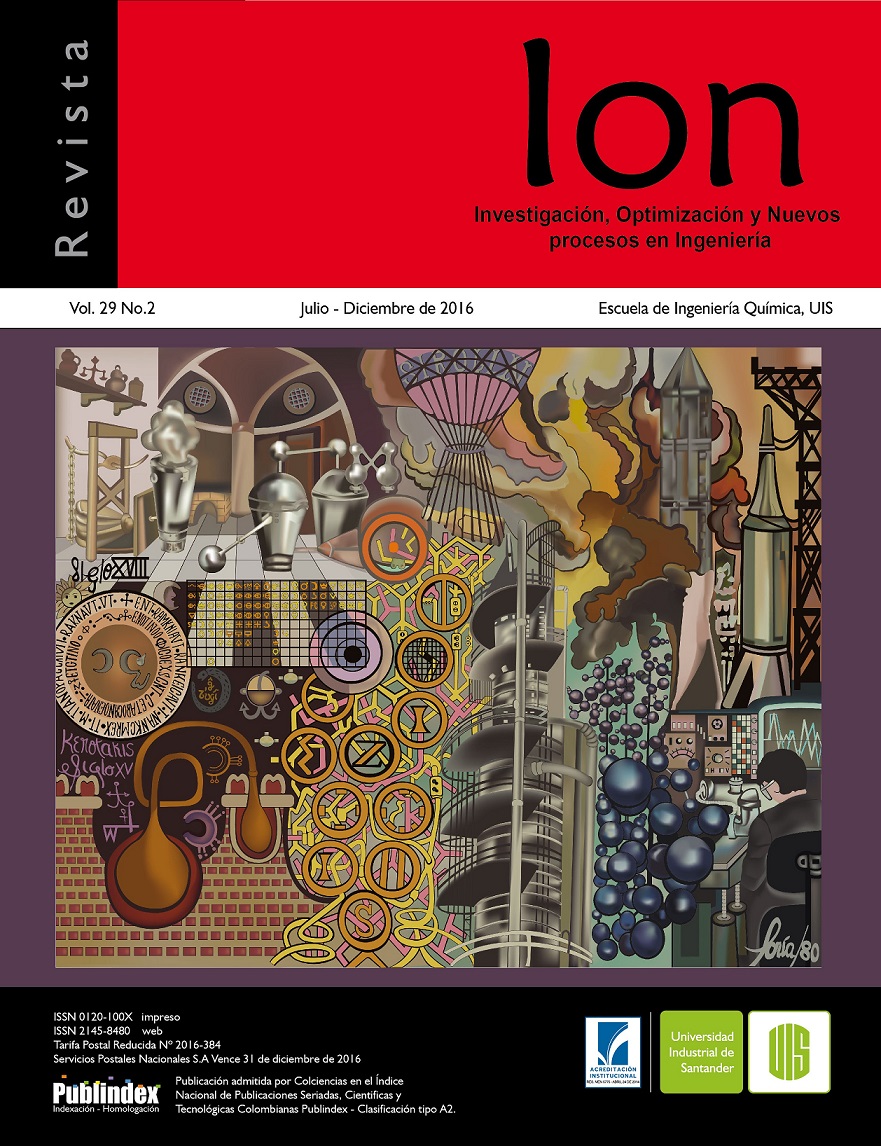Published 2016-12-15
Keywords
- Coated Fabric,
- TiO2-SiO2,
- Photocatalysis,
- E. Coli Inactivation.
How to Cite
Abstract
TiO2-SiO2 coatings on fabric samples were obtained by immersion of 9 cm2 of commercial polyester in a TiO2-SiO2 suspension. This suspension was prepared by adding TiO2 P25 to a silica matrix obtained from the hydrolysis of tetraethyl orthosilicate (TEOS). The aim of this work was to study the relationship between the immersion time of the fabric on the photocatalytic activity and stability of the coating against several cycles of use and washing. Obtained samples were characterized by scanning electron microscopy (SEM), energy dispersive spectroscopy (EDS) and infrared spectroscopy (FTIR-ATR). Evaluation of modified fabrics was performed by self-disinfection tests under 250W/m2 of simulated sunlight using E. coli as model bacteria. In general, all modified fabrics (except that obtained at 2h immersion time) inactivated bacteria in less than 120min and its regrowth was prevented for at least 24h after the disinfection tests. It was determined that low immersion time (3-4h) lead to active and stable fabrics to 3 cycles of use and washing, whereas higher immersion times (12h) lead to more active but unstable fabrics.
Downloads
References
[2] Yuranova T, Laub D, Kiwi J. Synthesis, activity and characterization of textiles showing self-cleaning activity under daylight irradiation Catal. Today. 2007;122:109–17.
[3] Wu D, Long M, Zhou J, Cai W, Zhu X, Chen C, et al. Synthesis and characterization of self-cleaning cotton fabrics modified by TiO2through a facile approach. Surf. Coat. Technol. 2009;203:3728–33.
[4] Mejía MI, Marín JM, Restrepo G, Pulgarín C, Kiwi J. Photocatalytic evaluation of TiO2/nylon systems prepared at different impregnation times. Catal. Today. 2011;161:15-22.
[5] Rincón AG, Pulgarin C. Absence of E. coliregrowth after Fe3+ and TiO2 solar photoassisted disinfection of water in CPC solar photoreactor. Catal. Today. 2007;124:204–14.
[6] Moncayo-Lasso A, Torres-Palma RA, Kiwi J, Benítez N, Pulgarin C. Bacterial inactivation and organic oxidation via immobilized photo-Fenton reagent on structured silica surfaces. Appl. Catal. B. 2008;84:577–83.
[7] Acosta S, Aragón JC, Benoit SR, Betancourt MI, Clara LI, Costa SF, et al. Evaluación de la infección hospitalaria en siete países latinoamericanos Rev. Panam. Infectol. 2008;10(4):112-22.
[8] Struelens MJ, Denis O, Rodriguez-Villalobos H. Mocrobiology of nosocomial infections: progress and challenges. Microbes Infect. 2004;6:1043-8.
[9] Sligl W, Taylor G, Brindley PG. Five years of nosocomial Gram-negative bacteremia in a general intensive care unit: epidemiology, antimicrobial susceptibility patterns, and outcomes. Int. J. Infect. Diseases. 2006;10(4):320-5.
[10] Cáceres Manrique FM, Díaz Martínez LA. Incidencia de infección nosocomial, ESE Hospital Universitario Ramón González Valencia, 1995-2000. MEDUNAB. 2002;5(13):5-13.
[11] Del Río J, Buriticá O. Evaluación de un sistema de vigilancia epidemiológica y riesgos de infección intrahospitalaria en pacientes quirúrgicos. Colombia Médica. 2000;31(2):71-6.
[12] Montazer M, Pakdel E. Functionality of nano titanium dioxide on textiles with future aspects: Focus on woolJ. Photochem. Photobiol. C. 2011;12(4):293– 303.
[13] Dastjerdi R, Montazer M. A review on the application of inorganic nano-structured materials in the modification of textiles: Focus on anti-microbial properties. Colloids Surf. B. 2010;79(1):5-18.
[14] Shan AY, Ghazi TIM, Rashid SA. Immobilisation of titanium dioxide onto supporting materials in heterogeneous photocatalysis: A review. Appl. Catal. A. 2010;389:1-8.
[15] Liu B, Wang Z, He J. SiO2/TiO2 multilayer films grown on cotton fibers surface at low temperature by a novel two-step process. Mater. Lett. 2012;67:8–10.
[16] Bellardita M, Addamo M, Di Paola A, Marcì G, Palmisano L, Cassar L, et al. Photocatalytic activity of TiO2/SiO2 systems. J. Hazard. Mater. 2010;174:707–13.
[17] Fakin D, Veronovski N, Ojstrsek A, Bozic M. Synthesis of TiO2–SiO2 colloid and its performance in reactive dyeing of cotton fabrics. Carbohydr. Polym. 2012;88:992–1001.
[18] Nakano R, Chand R, Obuchi E, Katoh K, Nakano K. Performance of TiO2 photocatalyst supported on silica beads for purification of wastewater after absorption of reflow exhaust gas. Chem. Eng. J. 2011;176–177:260–4.
[19] Lim LL, Lynch RJ, In SI. Comparison of simple and economical photocatalyst immobilization procedures. Appl. Catal. A. 2009;365:214-21.
[20] Li F, Xing Y, Ding X. Silica xerogel coating on the surface of natural and synthetic fabrics. Surf. Coat. Technol. 2008;202(19):4721–7.
[21] Mejía MI, Marín JM, Restrepo G, Rios LA, Pulgarín C, Kiwi J. Preparation, testing and performance of a TiO2/polyester photocatalyst for the degradation of gaseous methanol. Appl. Catal. B. 2010;94(1-2):166–72.
[22] Weenk GH. Microbiological assessment of culture media: comparison and statistical evaluation of methods. Int. J. Food Microbiol. 1992;17(2):159-81.
[23] Pakdel E, Daoud WA. Self-cleaning cotton functionalized with TiO2/SiO2: Focus on the role of silica. J. Colloid Interface Sci. 2013;401:1–7.
[24] Permpoon S, Houmard M, Riassetto D, Rapenne L, Berthomé G, Baroux B, et al. Natural and persistent superhydrophilicity of SiO2/TiO2and TiO2/SiO2 bi-layer films. Thin Solid Films. 2008;516(6):957–66.
[25] Martinez JR, Ruiz F. Mapeo estructural de sílica xerogel utilizando espectroscopia infrarroja. Revista Mexicana de Física. 2002;48(2):142-9.
[26] Jaroenworaluck A, Pijarn N, Kosachan N, Stevens R. Nanocomposite TiO2–SiO2 gel for UV absorption. Chem. Eng. J. 2012;181–182:45–55.
[27] Rincón AG, Pulgarin C. Effect of pH, inorganic ions, organic matter and H2O2 on E. coli K12 photocatalytic inactivation by TiO2: Implications in solar water disinfection. Appl. Catal. B. 2004;51(4):283–302.
[28] Pulgarin C, Kiwi J, Nadtochenko V. Mechanism of photocatalytic bacterial inactivation on TiO2 films involving cell-wall damage and lysis. Appl. Catal. B. 2012;128:179–83.
[29] Selishchev DS, Karaseva IP, Uvaev VV, Kozlov DV, Parmon VN. Effect of preparation method of functionalized textile materials on their photocatalytic activity and stability under UV irradiation. Chem. Eng. J. 2013; 224:114–20.

